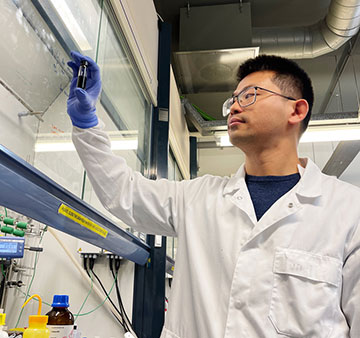
Researchers at the Institute of Photonic Sciences in Barcelona, Spain, have made quantum dots with nontoxic silver telluride, using novel precursors to ensure controllable crystal diameter and infrared absorption. Here, lead author Yongjie Wang is shown with a sample of the group's quantum-dot solution. [Image: ICFO]
The tiny slivers of semiconductor known as quantum dots could potentially enable cheap and compact photodetectors able to pick up shortwave infrared light, leading to new kinds of machine and night vision. But commercialization of such devices has been hampered by a lack of environmentally friendly nanocrystals able to absorb radiation at the necessary wavelengths.
Researchers in Spain reckon they have overcome this problem by devising a new way to synthesize colloidal quantum dots from silver telluride (Nat. Photon., doi: 10.1038/s41566-023-01345-3). They have shown the promise of this material by using it to make a sensitive broadband photodetector, which they then combined with an integrated circuit to create a CMOS-based image sensor.
Exploiting SWIR
Shortwave infrared light (SWIR), whether from sunlight or lasers/light-emitting diodes, is well suited to a range of sensing and imaging applications. Since it is harmless to the human eye and able to penetrate fog and haze, its detection could be exploited in self-driving cars and environmental monitoring. It could also enable passive night vision, while the incorporation of spectroscopy might lead to new kinds of biomolecular imaging and food inspection.
Current SWIR detectors are not cheap, as they rely on costly epitaxial semiconductors that are tricky to integrate with complementary metal–oxide–semiconductor electronics. Colloidal quantum dots, which are synthesized from solution, could in principle reduce manufacturing costs significantly while being compatible with CMOS technology. To date, however, the materials employed have been toxic heavy metals such as lead and mercury.
Silver telluride
Gerasimos Konstantatos and colleagues at the Institute of Photonic Sciences (ICFO) in Barcelona say they have now shown how to do away with the heavy metals. They were originally looking at how to synthesize nanocrystals of silver bismuth telluride in order to improve the performance of solar cells. But in the process, they created silver telluride, which they found they could tune to absorb specific wavelengths of SWIR—suggesting its suitability for photodetectors.
To make the necessary quantum dots, however, Konstantatos and coworkers had to find new precursors—chemical compounds that decompose when dissolved and heated, yielding monomers that then nucleate into nanocrystals (the quantum dots). The researchers' challenge was to control the size of the nanocrystals so that they absorb specific shades of infrared radiation, with larger crystals being sensitive to longer wavelengths. They say that the most commonly used precursor for silver telluride, tri-alkyl-phosphine-tellurium, yields poorly defined absorption peaks because the crystals end up with a wide range of diameters.
After screening various combinations of precursor candidates, the researchers settled on a pair of phosphine-free tellurium molecules called silver–oleylamine and tellurium–thiol. They went on to make spherical nanocrystals with five different diameters between about 3 and 7 µm, and they found that they could accurately tune the sizes—and hence the absorption peaks—by varying the reaction temperature and supply of precursors. The crystals' uniform size and shape was confirmed by transmission electron microscopy, while their absorption spectrum revealed fairly distinct peaks, between 1310 and 1940 nm, corresponding to each of the different-sized crystals.
Proof of concept
The researchers then used the quantum dots to make a SWIR photodetector. The detector stack consisted of five layers of silver telluride nanocrystals, with a gold electrode on top and several other materials below—glass covered with indium tin oxide and a silver-bismuth-sulfide buffer layer to limit noise from dark currents. This setup enabled high sensitivity and a linear response across a broad range of input powers, yielding a room-temperature detectivity of around 1012 Jones, a 3 dB bandwidth above 0.1 MHz and a linear dynamic range of over 118 dB.
Finally, working with colleagues at the ICFO spinoff company Qurv, the researchers combined their photodetector with a readout integrated circuit to demonstrate a proof-of-concept image sensor. By illuminating objects with SWIR, they found that the new device could reveal details that remained hidden in photographs obtained with a silicon-based camera from a standard cell phone. For example, they were able to read a logo otherwise obscured by a silicon wafer and observe the liquid inside a dark bottle.
Before they can commercialize such a device, however, Konstantatos says that he and his colleagues need first to make it more resilient and more efficient—looking to double the number of charge carriers generated per incident photon. He adds that they are also working to reduce the device's dark currents.
